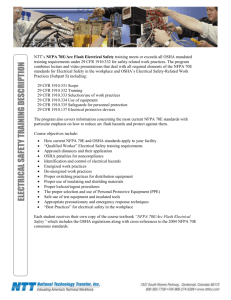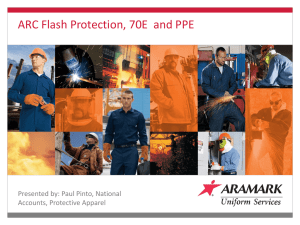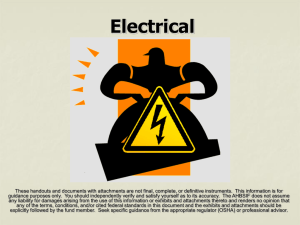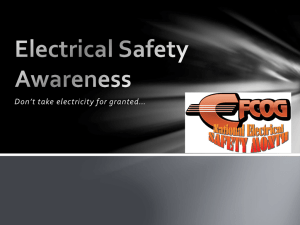ARC Flash Safety
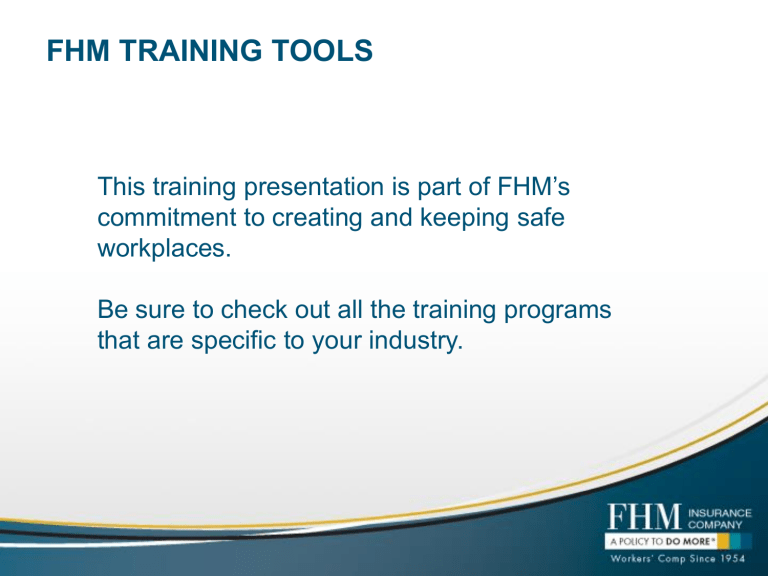
FHM TRAINING TOOLS
This training presentation is part of FHM’s commitment to creating and keeping safe workplaces.
Be sure to check out all the training programs that are specific to your industry.
►►►
Arc Flash Safety
These materials have been developed based on applicable federal laws and regulations in place at the time the materials were created. The program is being provided for educational and informational purposes only and does not constitute and is not intended to provide OSHA compliance certification, regulatory compliance, a substitute for any "hands on“ training required by applicable laws and regulations, or other legal or professional advice or services. By accessing the materials, you assume all responsibility and risk arising from the use of the content contained therein.
©2010 Grainger Safety Services, Inc.
Learning Objectives
After this course, you will:
► Understand the Arc Flash Hazard
► Recognize National Consensus
Standards on the topic
► Be familiar with the
OSHA requirements
Course Agenda
Presentation Agenda:
► Introduction to Arc Flash
► National Consensus Standards
► The OSHA Position
Section 1
Introduction to
Arc Flash
Arch Flash
Arc flash or arc blast is:
► The arc of high-amperage currents through the air.
► A discharge of high voltages across a gap between conductors
– The current travels through the air
– Temperatures as high as
35,000 ° Fahrenheit
Causes
What causes an arc flash?
► Bridging electrical contacts with a conducting object
► Dropped tools
► Buildup of conductive dust or corrosion
Arc Flash Conditions
Arc flash conditions:
► Working on an energized circuit
► Electrical equipment failure
Arc Flash Hazards
Three primary hazards:
1.
Thermal radiation and intense heat
2.
Pressure wave blast
3.
Molten metal
Thermal Radiation and Intense Heat
Factors affecting degree of injury :
► Skin color
► Area of skin exposed
► Type of clothing worn
To reduce risk of burn:
► Proper clothing
► Work distances
► Over-current protection
Pressure Wave Blast
Pressure wave blast:
► 25,000-amp arc:
– Feels like a force of about 480 pounds
– May cause serious ear damage
– May result in memory loss due to concussion
Pressure wave may throw victim:
► May propel objects over great distances
Molten Metal
High-voltage arcs can melt electrical equipment:
► Molten metal may be propelled great distances
Section 2
National
Consensus
Standards
National Consensus Standards
National Consensus Standard:
► Promulgated by a nationally recognized standardsproducing organization
► Offers opportunity to consider diverse views
► Designated by the Secretary
Compliance with National Consensus Standards
The OSH Act:
► Only national consensus standards that have been adopted as, or specifically incorporated by reference into, an OSHA standard provide a means of compliance with the OSH Act
► While requiring employers to comply with OSHA standards, the OSH Act also authorizes OSHA to treat certain violations, which have no direct or immediate relationship to safety and health, as de minimis , requiring no penalty or abatement
NFPA 70E
Standard for Workplace Electrical Safety:
► Wide range of electrical safety issues
► Assist employers comply with OSHA standards
Four Protective Strategies
Four protective strategies:
1.
Creating an electrically safe work condition
2.
Training workers
3.
Planning the task
4.
Selecting and using personal protective equipment
Terminology
Understanding terminology is essential to implement control measures
Arc Flash Hazard Analysis
Arc Flash Hazard Analysis:
► Measures incident energy that may strike an employee
► Determines the arc flash protection boundary
► Establishes the personal protective equipment necessary
► Helps create practices to accomplish the desired work
Working Distance
The working distance:
► Distance from where worker stands to flash location
► Common distance is 18 inches
► Incident energy can be used to select protective equipment
Incident Energy
Incident energy:
► Measure of thermal energy at working distance from an arc fault
► Measured in Calories per square Centimeter, or cal/cm 2
► 2nd degree burn of human skin is at 1.2 cal/cm 2
Arc Flash Protection Boundary
The Arc Flash Protection Boundary is the distance from which a person could receive a second degree burn
How to Use NFPA 70E
NFPA 70E is valuable in complying with the OSHA electrical standards
Section 3
The OSHA
Position
OSHA Use of National Consensus Standards
OSHA standards as they relate to NFPA 70E:
► OSHA does not enforce requirements of NFPA 70E
► NFPA 70E can be used by OSHA and employers as guides in making hazard analyses and selecting control measures
The General Duty Cause
Does OSHA issue General Duty Clause violations to companies who do not follow the new NFPA 70E?
► A violation of the General Duty Clause exists if an employer fails to furnish a workplace that is free from recognized hazards
► The General Duty Clause is not used to enforce the provisions of consensus standards
► The General Duty Clause usually is not used if there is a standard that applies to the particular condition, practice, means, operation, or process involved
Marking of Electrical Equipment
OSHA has no specific requirement for marking of electrical equipment to warn qualified persons of potential arc flash hazards.
► Paragraph (e) of 1910.303 requires employers to mark electrical equipment with descriptive markings, including the equipment's voltage, current, wattage, or other ratings as necessary
Flame-Resistant Clothing
Is flame-resistant clothing required for employees working on electrical installations covered by Subpart S?
► OSHA's present requirements in Subpart S, Safety-Related
Work Practices , are based on NFPA 70E-1983, which did not at that time include specific provisions for flame-resistant clothing
► More recent versions of NFPA 70E have included such body protection provisions
► OSHA's existing Subpart S does not include a specific requirement for fire-resistant clothing
OSHA-Requires De-energization
OSHA provisions for selection and use of
work practices contained in 1910.333(a)(1) generally require de-energization of live parts before an employee works on or near them.
► Exposure is limited to when the equipment is shut down and when the qualified employee verifies, by use of a test instrument, a deenergized state
► When employees perform work on energized circuits, as permitted by 1910.333(a)(1), tools and handling equipment that might make contact with exposed energized parts must be insulated in accordance with 1910.335(a)(2)(i)
Additional OSHA Requirements
Personal protective Equipment (PPE):
► Must be worn for eyes and face when there is danger of injury
► Use equipment to protect employees from:
– Electric shocks
– Blast
– Arc flash burn hazards
Supplemental Steps to Ensure Worker Safety
NFPA 70E-2004 standards:
► Arc Flash Hazard analysis
► Flash-protection boundary
► Personal protective equipment
NFPA 70E, Article 130 provisions:
► Energized electrical work authorization permit
► Brief employees before they start each job
Additional Information
Additional Information:
29 CFR 1910 Subpart S, Electrical
National Fire Protection Agency:
NFPA 70E: Standard for Electrical Safety in the Workplace
®
2009
OSHA 3075:
Controlling Electrical Hazards 2002

